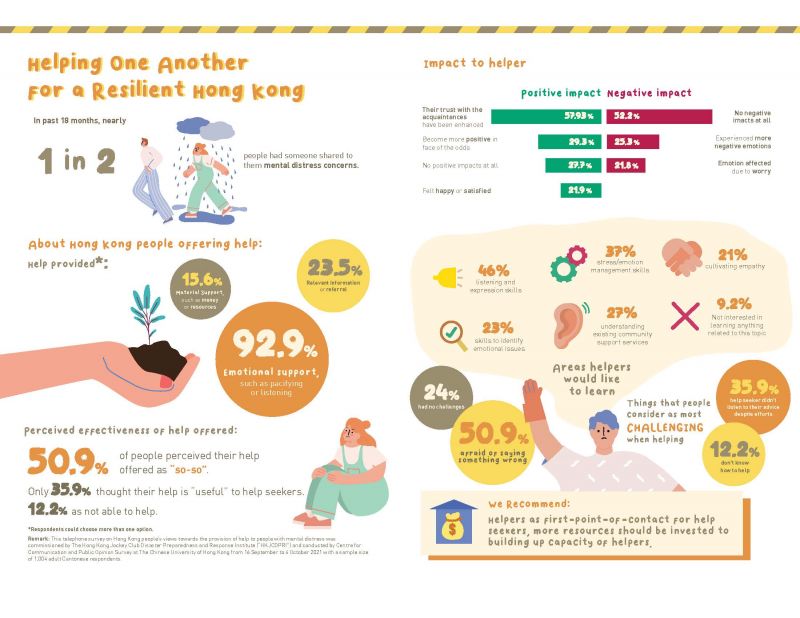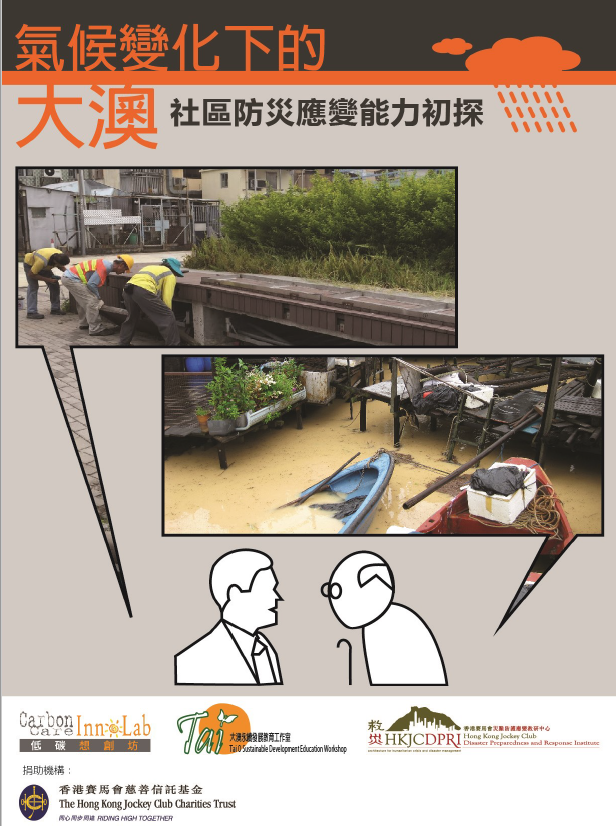You are here
Population based survey about Hong Kong people’s views towards the provision of help to people with mental distress
Population based survey about Hong Kong people’s views towards the provision of help to people with mental distress
The Hong Kong Jockey Club Disaster Preparedness and Response Institute (“HKJCDPRI”) has commissioned the Centre for Communication and Public Opinion Survey (“CCPOS”) at The Chinese University of Hong Kong (“CUHK”) to conduct an opinion survey about Hong Kong people’s views towards the provision of help to people with mental distress (“the Survey”). Specfically, the Survey aimed to examine the following issues:
- Opinions on providing help to people with mental distress
- Mental distress situation of acquaintance
- Situations of providing help to acquaintance with mental distress
- Opinions on learning how to acquaintance with mental distress

A telephone survey was conducted from 16 September to 4 October 2021 with Hong Kong residents aged 18 or above (Cantonese speakers), which produced a sample size of 1,004 respondents. The main findings of the Survey are summarized as follows:
Opinions on providing help to people with mental distress
- The respondents were asked whether they would be willing to provide help when other people mentioned their mental distress (such as unhappiness, worry, anexiety or anger, etc.) to them. Over seven in ten repsondents (71.9%)said they were willing to help; more than one-fifth (22.5%) said “so-so”; and only a tiny portion (3.2%) said not willing.
- If there were a need for the respondents to help the people with mental distress, over half of them (56.7%) said their confidence level of provding useful help to the people in need was just “so-so”. The proportion of respondents lacking confidence (23.5%) was higher than that of respondents having the confidence (18.3%).
- The respondents thought that the main difficulties of helping the people with mental distress were “don’t know how to help them” (44.3%), “don’t know how to pacify them” (32.0%), “no time” (20.1%) and “don’t understand their troubles” (19.9%)。
Mental distress situation of acquaintance
- Nearly half of the respondents (47.9%) have had their acquaintances (including family members, friends, colleagues, classmates, neighbours or people they met in work) mentioning to them about their mental distress (such as unhappiness, worry, anexiety or anger, etc.) in the past 18 months. And over half of the respondents (52.1%) said they have not encountered this situation.
- Those acquaintances were mainly the “friends” (65.3%), “family members” (31.2%) and “colleages” (20.4%) of the respondents.
- The main sources of mental distress of those acquaintances were about “family” (37.0%) and “work” (36.7%) and as well as “social events” (30.0%) and “the pandemic” (29.2%).
- According to the respondents, those acquaintances mainly had the following symptoms of mental distress: “easy to feel depressed, worried or panicky” (47.9%), “easy to feel anxious, angry or frustrated” (43.6%) and “always suffer from insomnia ” (43.3%).
- Over half of the respondents (51.5%) said that, there was no difference in the number of people mentioning to them about their mental distress between now and before the pandemic. However, more than two-fifths of the respondents (45.7%) said the number of help-seekers has increased; whereas a tiny portion of the respondents (2.4%) said there were fewer help-seekers now.
Situations of providing help to acquaintance with mental distress
- For those respondents who have had their acquaintances mentioning to them about their mental distress in the past 18 months, the overwhelming majority of them (98.1%) have tried/ sometimes have tried to provide some forms of help to the help-seekers, such as listening to their concerns or providing them information or advices. Only a tiny portion of the respondents (1.9%) have not tried to provide any help at all.
- The help being provided by the respondents was mainly “emotional support, such as pacifying or listening”(92.9%). It was then followed by “provding information or referral” (23.5%) and “material support, such as money or resources, etc.” (15.6%).
- In the helping process, the main difficulties encountered by the respondents were “afraid of saying wrong things” (34.4%), “the help-seekers were not listening even I have already spoken a lot” (34.2%) and “don’t know how to help” (31.0%).
- The respondents were asked to evaluate whether their provided help could be able to help the help-seekers. Around half of the respondents (50.9%) said the outcome was only “so-so”. Over three in ten respondents (35.9%) believed that their help was useful for the help-seekers; however, over one in ten respondents (12.2%) believed that their provided help was not able to help the help-seekers.
- Nearly three-fifths of the respondents expressed that having provided help to the acquaintances with mental distress, “their trust with the acquaintances have been enhanced” (57.3%). Nearly three in ten respondents said that they “have become more positive in face of the odds” (29.3%). Moreover, about one-fifth of the respondents “have felt happy or satisfied” (21.9%). However, there was also more than a quarter of the respondents (27.7%) experiencing “no positive impacts at all” in helping others.
- As far as negative impacts are concerned, over half of the respondents (52.2%) said that providing help to the acquaintances with mental distress has caused “no negative impacts” on them. However, over one-fifth of the respondents have said “they have experienced more negative emotions” (25.3%) and “their emotion has been affected because of worry” (21.8%) respectively.
- As mentioned above (point 9), some respondents have not tried/ sometimes have not tried to provide help to the acquaintances with mental distress. Their main reasons were “don’t know how to help” (47.9%), “the relationship with them wasn’t that close” (18.3%), “they may not want me to help them” (11.9%), “just trivial matters; no need to help” (10.7%) and “afraid of being troubled” (7.9%).
Opinions on learning how to acquaintance with mental distress
- Finally, the Survey asked all respondents what knowledge or skills they would like to learn for helping people with mental distress. The top choice was “listening and presentation skills” (46.2%), which was followed by “the methods of reducing stress or releasing emotions (36.6%), understanding“existing supportive services in the community” (26.8 %), “identifying emotional health problems” (22.7%) and “cultivating empathy” (20.6%). However, close to one in ten repsondents (9.2%) have expressed no interest in all above-mentioned items.






